After a certain amount of time, Magic players begin to express their personal opinions on the qualities of a particular card(s). This can happen early on, as a neophyte is wrecked by something over and over again. Shivan Dragon perhaps, or Hypnotic Specter. For others, it can take longer. I know in my opening years, every spell seemed so different and cool that rankings would be meaningless. Of course, people have their preferences; their favorite cards and favorite colors. But even after you can pick cards you love and cards you hate, it takes a fair amount of experience with the game before you can reach the level where you’d say, “card X is a mistake,” or “card Y should never have been printed.”.
The people reading this have most likely made it to that level, probably quite a long time ago. Everyone, sooner or later, says R&D made a mistake with a certain card, or mechanic, or set. The thing is, the person saying it could very well be right. Wizards usually agrees; ask any current or former R&D employee and they’ll probably say mistakes have been made during their tenure (although they might disagree on what that error actually is).
The thing is – and take this statement with the author’s continually increasing experience – creating sets is hard! It’s surprisingly difficult. You have to juggle many, many factors to make a bunch of cards fun and challenging and interesting. Which is not to say we don’t like to try.
Once a while, me and the boys get together and run the BOO (Build Our Own) experience. We’ve been doing this for quite a while. The last incarnation was the third attempt. The BOO experience is a total one: card names, casting costs, function, flavor text, art… After they’re made, we shuffle ‘em into packs and draft ‘em up. It’s a pretty simple process: make 45 interesting Limited cards, and play with them. The power and flavor quotients are entirely in your hands.
This is clearly a lot of responsibility. There’s a slight check on the designer’s power, which I’ll address later, but for the most part, your influence has immense effect on the game as a whole. A mistake in the creation phase will ripple across the playing field for a long time to come. This is, I’m sure, a concern in R&D. Also like real life, there’s a very interesting pendulum effect. For example, in BOO2 we had an extreme quantity of removal spells. The creatures were good, but those insane removal spells killed ‘em all, and probably did five to the nugget on the way out. This time the people, recalling BOO2, came to the table with fewer removal spells, and the ones there were weaker versions than in BOOs past. Also remembering BOO2, people made their creatures stronger and more resilient. Now we have less removal combating better creatures; a brand new environment for BOO3. Despite everything remaining player-made, there is a gigantic shift in how the games played out. Another parallel; Saga to Masques, anyone? This was all after-the-fact knowledge, of course. In the meantime, BOO3 was on. We had some making to do.
Most of the eight had some degree of structure to their set. My cards were a little more free-flowing, but I did have three points always at the forefront of my mind whilst inventing:
1. Create new mechanics.
2. Create cards that could actually be printed.
3. Make some cards funny.
I’d say I scored about a 75% in all three categories. My first mechanic was simply a cycle of creatures that could also be played as auras. The Licids v2.0 all had reasonable abilities and generally fair effects on the game. Here is one of the five:
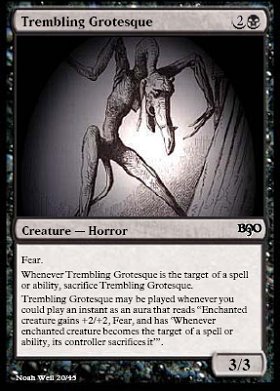
Yes I know it should be “world enchant creature aura creature creature”, or whatever, but space was tight and BOO drafters are smart folk. A few other cards had shortcuts because everyone playing was proficient with intent. This was definitely not a reflection of real life Magic.
The second mechanic was called Knowledge Seek:
Knowledge Seek X: As a creature with Knowledge Seek would come into play, instead remove it from the game. As long as a card with Knowledge Seek is removed from the game, whenever you would draw a card, instead place the top card of your library face down underneath a creature with Knowledge Seek. When that creature has X or more cards underneath it, you may put all face down cards underneath the spell in your hand and play the creature without paying its mana cost, whenever you could play an instant. That creature then loses Knowledge Seek.
This one was a bit of a miss. I liked the flavor and impact of this design, but the actual cards were costed pretty poorly. The red dragon was a whopping six mana for a creature with Knowledge Seek: 3. Its abilities were useful, but at that price waiting three turns was just too long. You were either already in a dominant position or getting crushed. If I could do it over, I’d price it at four mana. I originally had a bunch of cards that got better the more cards left underneath them, but most lost out in the numbers. Here’s one that stuck around:
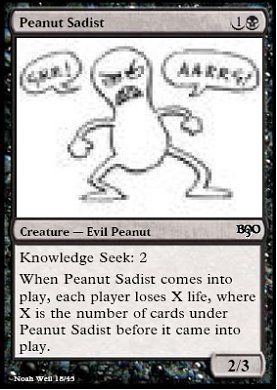
As far as the second two categories, I’m mostly proud of what was made. While I consider most of the cards pretty fair, here were two that got eliminated in the second development phase (see below).
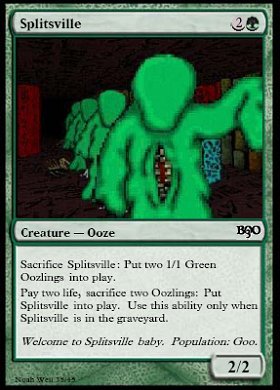

I adore Splitsville’s flavor, while Current Attraction is just really good. Although it was a lot better when it read “spell or effect deals 2 damage…”
One of the major differences of BOO and real life Magic is that, unlike the real stuff, BOO cards are designed solely for Limited play. Designing cards people will draft versus cards people may put into Constructed decks is far easier, especially when the overall card pool is so small. This is actually a very important point, because people believe they’re not allowed to create obviously broken Constructed cards for an event solely designed for Limited play. Clearly, a lot of this stuff would never get printed in real life, because of Standard concerns. However, designing cards only for Limited play is, I believe, liberating. Should you decide to participate in a BOO event, don’t restrict yourself because a particular card would be insane in Extended, or has Un-qualities, or whatever. The challenge is to make 45 interesting, draftable cards – nothing more and nothing less. I said my goal was to make printable cards, and that’s true, but clearly some of those printable ones would be very good in Constructed. How good they’d be is an interesting question, but their Limited performance was much more relevant, and as it turns out, satisfying. Watching one of your cool and interesting cards beat the crap out of someone is such a pleasurable sight. Were I real R&D member, I could never attend a large tournament. It would be far too erotic.
Here, in detail, is the BOO experience from beginning to end. It starts some evening at a guy’s house, where eight people are drafting. Someone says “hey, we should do a BOO draft”, and people, remembering the good times from BOO sets past (or reading this series of articles, I suppose), agree and set a date. Usually it’s about a month hence, although being Magic players, you can add two weeks to whatever actual final date is reached. If four weeks seems too long, remember that while it’s easy to make cards that suck, it’s much more of a challenge to make 45 all-stars. Especially if this is your group’s first time, I’d err on the side of more time rather than less.
So begins the creating phase. I can’t speak for my BOO colleagues, but my method is pretty varied. I find a piece of art I like? I’ll make a card for it. I want some Green removal? Red untargeted removal? A card that enhances Knowledge Seek? Check, check, and check. I’d say top-down design, flavor design, and mechanical design were represented in equal thirds. I have no idea how the professionals do it, but I’m guessing my style is pretty inefficient. Instead of a structured process, I’d be inspired out of the blue, sometimes at inopportune times. I ended up with many more card ideas than were actually printed. |A lot of them were, most likely, garbage. I’m sure that devoting some genuine creation time, with a structured plan, is better than waiting to get struck by lightning. Your particular technique may vary, or it may not. I wonder if learning styles – Myers-Briggs types, etc – have anything to do with the process. People that do this for a living, and I’m speaking now of anything involving sequential creativity (game making, advertising, software engineering, and so on) figure out how best they operate and when they’re most brilliant. For me and mine, this is a hobby. Idealized, efficient fluidity isn’t a priority. So I’m left with waiting for proverbial light bulbs to flash overhead. Which is not to say I wasn’t adverse to the occasional assistance from anyone that offered.
Near the very end of the submission phase – say week 3.5 – I was still stuck for two final ideas. There were more than 45 cards in the file, but I wanted something a little more… engaging. A couple of friends were over one evening, and I told them of my concerns. One thing led to another, and they were totally helpful engaging my latent creative processes. As we were sitting on the couch, working on a very large pizza and drinking Fruitopia, my buddy Jill was telling me about her domestic woes…
“I live next to this park, and there’s all these f***ing, uh I don’t know, woodmen running around. And their dogs! Man they suck!”
“Woodsmen? Like, grizzled dudes?”
“Yeah! Totally! And their stupid pitbulls. You should, like, make a card about these woodsmen and the pitbulls”
“Done and done.”
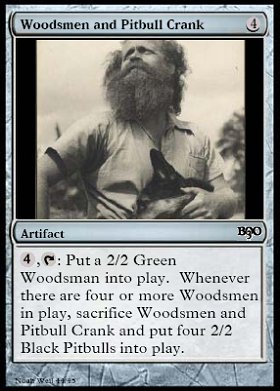
This design is inspired, in every sense of the word. The other card they graciously assisted on was this one. This title and art, if you’re wondering, came from an actual, real-life movie, found in a real-life video store. No matter how much I enjoy Magic, I love this country.
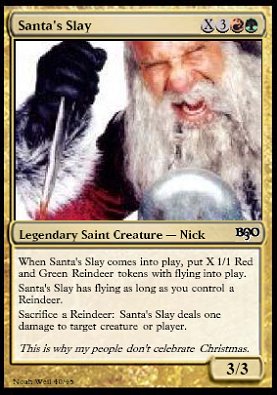
With the final 45 decided, the group proceeded to the next stage: development part 1. A very important phase. See, the BOO process has some inherent conflict. On the one hand, everyone wants to be surprised with brand new cards. Pre-releases are a lot of fun, after all. On the other hand, card designers might have left power concerns or template issues, although power is the real concern since that’s the component that can take away the fun. The solution we choose is to give your set to one other person in the group. They give their set to one other person, and so on, so that everyone has a brand new pool to investigate for power or rules concerns. This solution is not perfect, but something is necessary. Even with another person’s check in the process, mistakes can and will happen. If that seems unlikely, consider that actual Wizards employees slip as well. Keep in mind they’re professional, and they have a lot more people on their teams (See: Umezawa’s Jitte, Oboro Envoy). I urge the readers not to get too bent out of shape over template or power issues on cards, since this stuff will happen. This is a really important point to me, because we’re all about having fun. Also, I really dropped the ball when it was my turn to check a set.
After dev1 is finished and all the cards come back clean and balanced (ha), it’s time for the physical printing process. We’ve got an ace in our corner, one Brett Allen, who both tunes the fonts and creates very snazzy expansion symbols. A big thanks to Brett Allen for his help on this one. If Mr. Allen is unavailable for your private gathering, any other associate of Industrial Light and Magic should fit the bill.
Once you have the files, take them to either to the guy with the high-quality color printer or your local Kinkos. We’ll all gather at a pre-determined store or domicile. The man in charge of printing comes in, triumphantly holding sheets with our little colored and colorless babies. I’m told by Anthony Alongi, co-author of Jennifer Scales and the Messenger of Light, that seeing your works in fresh, vibrant ink is a heady feeling. Indeed it is so, and everyone has big smiles as they get to work cutting their sheets into playable cards.
This aspect does require a bit of preparation. You’ll need a bunch of scissors, a lot of worthless commons, a lot of lands, and about 550 sleeves of the same type and color. The commons are put into sleeves, then the paper thin BOO cards are slid into those sleeves, in front of common X. Then, as promises oh-so-long ago, you’ll be holding your very own card in genuine sleeve and thickness. You’ll need 450 cards for the actual BOO cards, plus sleeves to hold the lands for the upcoming decks. This is a lengthy process, made longer by people showing other people cards they’re particularly proud of and/or doing shots. About now, I’d recommend lunch.
When the cards are finally sleeved and ready to go, make packs of fifteen. How you do this is up to you, but I’d suggest some degree of color balance. There are the five colors of course, plus gold and colorless. Sometimes there are so many lands or artifacts that those categories can be divided further. Regardless, shuffle up the cards of each type and make sure each booster as at least one of each category in it. Most people make their sets fairly balanced, so it shouldn’t be too onerous, plus you’ll have a lot of stuff left over for “realistic” disproportion.
And… draft! Everyone’s put in the work, now its reward time. Other columns exist for explaining how to draft, but it’s not a big deal as winning isn’t the issue. We don’t have prizes or a structured setting; after you’re done playing someone, play someone else. We didn’t need to play for anything – this time, the experience was its own reward.
I personally thought this collection was our best work to date. Here are some of the more interesting cards from the other players in BOO3.
Beni Rose
Beni’s theme was Battletech, for reasons that escape me. Beni did have one of the more engaging mechanics of the environment, Manufacture:
Manufacture: A card with manufacture can be played face down as a zero casting cost artifact. At sorcery speed you can spend 1 to put a counter on it. When it gets counters equal to or greater than the manufacture cost, you may the card face up at sorcery speed.
Everyone loved Manufacture because you got to spend your mana every turn. The cards and the mechanic were remarkable strong; in real life the Manufacture costs should probably be increased by at least five. Here’s the fairest Manufacture card, and a Blue sorcery that everyone thought was particularly cool:
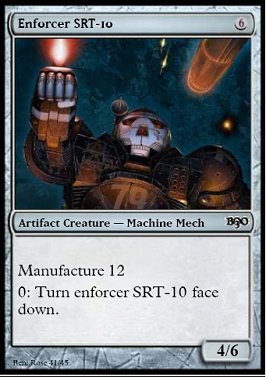
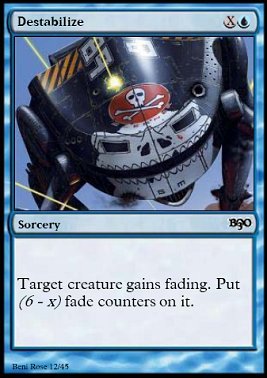
Brian Wong
Brian didn’t have an overarching theme in his cards, just clever and well though out submissions. His mechanic, Ruthless, involved creatures dying. It was an ideal Limited mechanic. Brian was disappointed that his Crapappyl card didn’t see more play, although Blue ended being probably the weakest color in BOO3. I’m particularly impressed with the subtlety of Cash Crop. Is this a card that could see play? Is it any good? There’s a lot of tension in such a (seemingly) minor card.
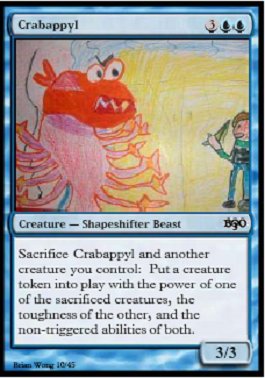
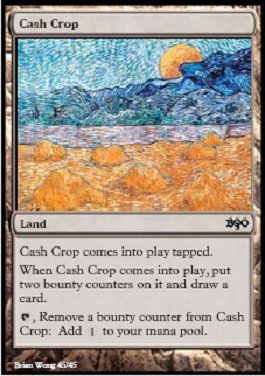
Christian Robertsen
Christian’s theme was penguins, polar bears, and insanity; not in that order. Christian’s cards were the only ones I could always recognize, because, well, they’re Christian flavorful. He’s such a quiet guy normally, but I guess he’s waiting for the right venue.
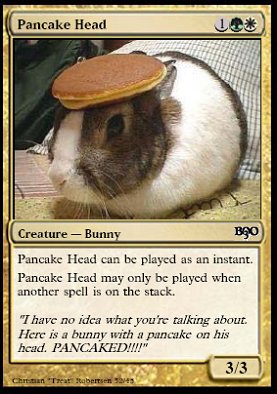
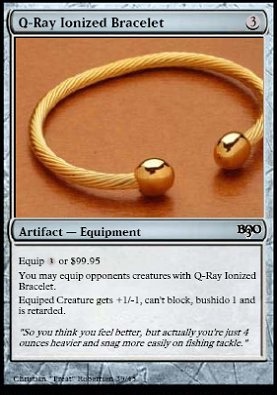
By the way, no one thought winning a meaningless game was worth $100, yet so competitive is this group that it became a near thing at one point. It may or may not be true, but I’m told at one point Eric offered $20 to Ricky Boyes, to pay for an equip cost. Ricky, however, turned him down. Whether it was because Ricky was adherent to the card’s wording, or that he simply didn’t want to lose the match is, of course, anyone’s guess.
Dan Diamant
“Diamond” Dan’s rather notorious for making cards a little above the curve. I think Beni took top honors in that category this time around (Commanche Stealth Chopper, ugh), but Dan did take a stab at it. Dan’s major mechanic was a class of cards called “Talents”. Talents are like Vanguard cards; you start with them in play and get their effects. I was in charge of Dan’s set, examining power levels and whatnot, and I admit I was intrigued by Talents. Sure, some of them looked a little too good, but would people really waste a pick on a card that didn’t necessarily do anything? The answer, it turned out, was an overwhelming yes. Talents were so good. They could’ve been made in such a way that they weren’t so exceptional, but I wanted to stay true to Dan’s vision. I received a bit of chiding for allowing the talents to stay in, but in my defense, they were originally much better. Beautiful, for example, has no activation cost. Fast was originally two life. Is it worth first picking Fastbond if you’re guaranteed to start with it on turn zero? Umm, probably.
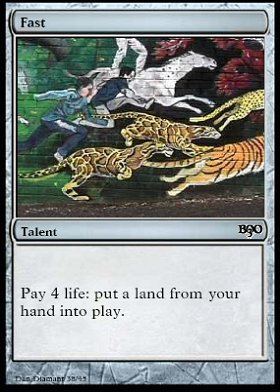
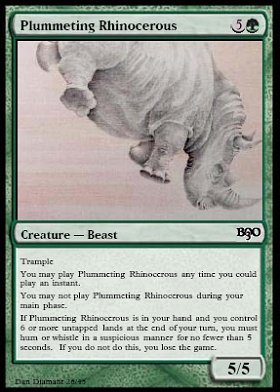
In the end, the talents experiment was a failure. I show the Rhino because I think it’s a cool card in general, and to emphasize that in the confines of the BOO-niverse, you’re not limited to “standard” mechanics. A little Un here and there never hurt anyone.
Eric Reasoner
Eric had a few sub-themes going, a remove-creatures-from-your-library-for-effect deal, and some very complicated text. All these cards were interesting in their way, although that first one in particular had a lot of design depth. Here’s one example:
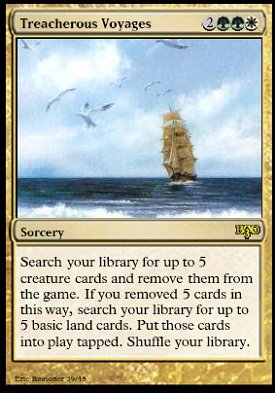
The “lots o’ text” mechanic was interesting from my perspective, because people weren’t willing to risk a pick on a card they weren’t quite sure about. This card:
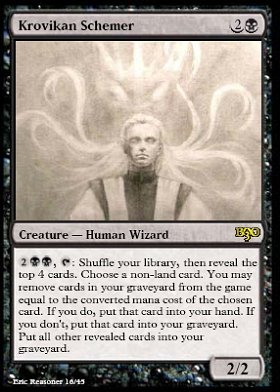
… is actually really good, but it went late because people were having trouble wrapping their heads around it. Similarly, the following card is extremely potent, yet it went very late because half the table either couldn’t or didn’t want to understand it.
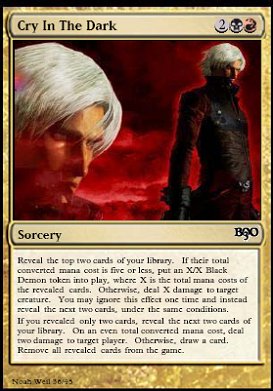
Finally someone realized the card is awesome and slammed it 5th or 6th pick. Is this a device you can use to win your BOO draft? Is this a useful tidbit of info for your next pre-release? I don’t know, but it’s certainly an interesting piece of data to observe.
Matt Ruhlen
Matt had a couple of plans running through his cards. His first was golem cycles, which were cards that had great abilities in hard-to-manage packages. It’s a pretty clever idea actually, although we agreed that they would have been more playable had they merely received their second ability based on not paying color X. Matt also had a cycle of lands that seemed amazing, but were actually a little worse than we thought. Tapping for two colors is nice, and the third ability is gravy but A) returning a land to your hand is a pain in Limited, and B) it was a rare deck that could utilize everything. So all in all, pretty elegant design.
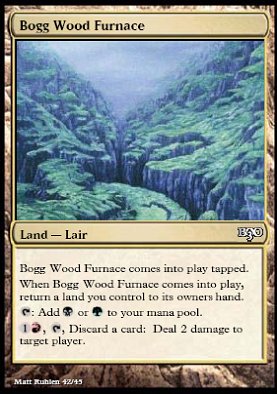
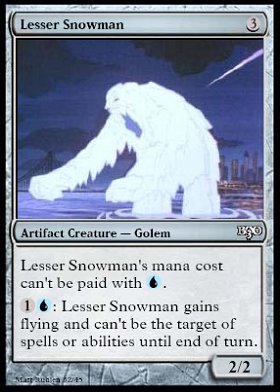
Ricky Boyes
Ricky had a couple of themes too; Transformers and taking things a bit too seriously. He was against Un-mechanics for a while, but the rest of us were so intrigued or proud of the cards, his objections were summarily vetoed. Ricky was also quite clever with his card design. I think Ricky was one of the designers most likely to get his stuff printed in its original form.
Myr Temp is not one of those cards, because lord knows how it would be templated in real life, but I think it’s a pretty cool idea nonetheless. Ricky also had the rather unique Awesomeclasm, one of the rare cards in BOO that would probably be fair in Constructed but ended up being super nice in solely Limited play. In a real set, Awesomeclasm could be printed as is, but I think for BOO it needed one or two more mana.
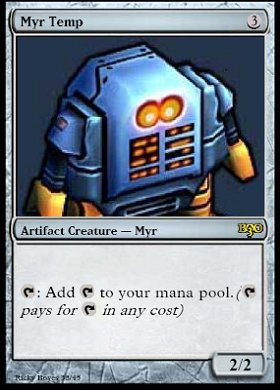
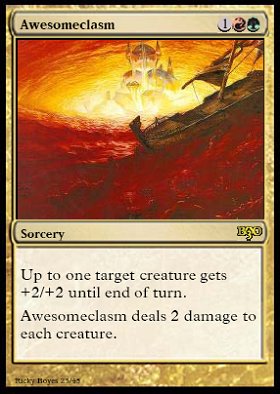
Ricky also had a very interesting cycle of dual lands; probably a design that should be printed in an upcoming set. If you’re interested, you can see all of Ricky’s cards, as well as everyone else’s here, although be warned a few cards are not work safe. That site has all of the BOO cards created so far. Brett Allen is graciously hosting those sets, should you have some extra time to kill.
Finally, the development phase part 2. After everyone has explored their deck and played enough rounds, we all get together for one more round of tweaking. Previously, this involved errata on particular troublemakers. In this case, mostly because of Dan and Beni, we just agreed to cut the worst 45 cards i.e. the most savagely overpowered. The vanguards got taken out, as well as few choice selections from each person’s set. With the power levels modified to a more reasonable manner, we drafted one more time, far more knowledgeable about the good cards and the bad. Almost everyone agreed the second draft was more fun than the first, which I think is the point. It was certainly a speedier event, with most people knowing most of the cards, although there were still a few surprises here and there. And then, after a very long day, we called it quits, declaring BOO3, like the BOOs before, a success.
Having been involved with this process for a while now, the subtleties of BOO creating and execution continue to impress. While it is on a micro scale, the parallels of this experience and real-life Magic design are genuine. It is simply a fascinating look into how the pros do it. Making fun and enjoyable cards is hard, and doing it on a consistent basis is even more so. It’s a learning process, with achievements and mistakes just like any other, made even more engaging by the number of factors one has to juggle. You have to get eight people to enjoy the made cards, a process that has more to do with prayer and relied intelligence than any kind of checks and balances in the system. Then you have to lay some power in your cards, to get people excited, but not have any of those 320 so over the top it’s ruinous for all. We probably failed these criteria numerous times, and all we had to do was satisfy eight people, not a million. It’s a tough job any way you slice it, but luckily it’s an awful lot of fun.
Should the idea of making environments tickle your fancy, or you just have a bunch of card ideas locked away, I urge you to give BOO drafting a try. It’s one of the most entertaining, and revealing, experiences a player and his friends can do.
As always, I look forward to questions or comments.
